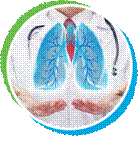Managing Supplemental Oxygen Supplies
For people living with chronic obstructive pulmonary disease (COPD), supplemental oxygen is one of the most important therapies available when they experience reduced oxygen levels. But effectively managing oxygen can be challenging. To help, the National Heart, Lung, and Blood Institute (NHLBI), part of the National Institutes of Health (NIH), has published tips for doing so, including managing tubing, keeping supplies clean, and practicing oxygen safety.
Managing Tubing
“Oxygen tubing is a frequent source of complaints from COPD caregivers and people who use oxygen,” notes NHLBI. Not only can oxygen tubing be a tripping hazard, but people can accidentally stand on it and cut off the oxygen supply. It can get caught in furniture, knock things over, or become a toy for pets (cats love to chew on tubing!).
To reduce these frustrations, ensure oxygen tubing stays close to the person with COPD and make sure there are clear pathways for walking, which will help prevent trips and falls. You may want to consider switching to portable or ambulatory oxygen tanks if they fit the needs of the person with COPD. Smaller with shorter lengths of tubing, these portable oxygen concentrators can be rolled in their own cases, worn in a backpack on the back or slung over the shoulder.
Keeping it Clean
Follow the cleaning instructions that come with oxygen equipment to keep it working properly. Your oxygen equipment supplier, or durable medical equipment supplier, can also share tips for proper cleaning and maintenance. NHLBI also provides the following checklist:
Check the instructions that come with the equipment. Don't hesitate to contact the equipment provider if you have questions.
- Clean the nasal cannula every week or as needed by washing in soapy water and rinsing with a solution of 10 parts water and one part vinegar. Rinse thoroughly with hot water and hang dry.
- An oxygen face mask, if used, should be cleaned twice weekly by washing with warm soapy water and rinsing with a solution of 10 parts water and one part vinegar. Rinse thoroughly with hot water and hang dry.
- Never wash or submerge the oxygen tubing in water, as doing so can cause mold growth inside it. Instead, wipe down the outside of the tubing routinely.
- Clean oxygen concentrator filters weekly with warm soapy water.
- Ideally, nasal cannulas should be replaced every two weeks and the long oxygen tubing attached to stationary equipment every three months.
- If the person you care for has been sick with a respiratory infection, replace the nasal cannula immediately.
- Store tanks that are in use in a stand or cart to prevent tipping and falling.
- Store extra, unsecured tanks flat on the floor.
- Keep oxygen supplies away from open flames.
- Review oxygen fire safety with your equipment provider.
- Post a “No Smoking” sign in every room where oxygen is used.
- Do not store oxygen systems in unventilated areas (e.g., closets or cabinets).
- Do not place clothing over oxygen systems.
Keeping it Safe
The size, shape and weight of oxygen tanks can make them difficult to physically manage and handle safely. But in this case “out of sight, out of mind” is not the safest approach. No smoking can be permitted in a room where the oxygen tank is located, nor can there be any open flames. Tanks should also be kept at least six feet away from any fire source (e.g., stove, fireplace, tabletop candle, etc.).
NHLBI provides the following safe oxygen equipment storage checklist:
Ensure you talk to your oxygen equipment supplier about oxygen device safety and oxygen tank storage tips.
More safety information can be found in NHLBI’s COPD Caregiver’s Toolkit, available here.
Creating a Safer Living Environment
For people living with chronic obstructive pulmonary disease (COPD), the role of the home often changes; some areas take on new meaning as they find themselves spending more time inside while others present new challenges or dangers. Further, poor indoor air quality can exacerbate COPD symptoms and affect how a person with COPD feels in their home. Thus, it’s important for caregivers and their loved ones to work together to manage indoor irritants and pollutants, avoid second- and third-hand smoke and even test for radon.
To help those with COPD and their caregivers create a safer home, the National Heart, Lung, and Blood Institute (NHLBI), part of the National Institutes of Health (NIH), recently published the COPD Caregiver’s Toolkit to share tips for creating a safer home for those with COPD. In addition to patient stories, the toolkit is designed to help “develop a new eye for the home environment. It can also help you anticipate new difficulties that arise as people with COPD negotiate new limitations.”
Managing Indoor Triggers
Managing and reducing contact with indoor irritants and pollutants is vital for reducing the COPD flare-up they can lead to. Among the most common indoor triggers are tobacco smoke, pet dander, dust and mold, tree and plant pollen, and strong odors (e.g., household cleaning products, perfume, etc.).
To manage these indoor triggers, avoid using smoke-producing items such as fireplaces, wood-burning stoves, and candles, and any products with strong odors, such as bleach, cleaning products, air fresheners, perfumes, etc. Reduce mold by repairing any water leaks, reduce dust and dust mites by vacuuming and dusting frequently, and keep pets out of sleeping areas.
Windows should be kept closed on high allergen days – information you can track with your local news station. Air conditioning should be used whenever possible, and heating and cooling systems should be inspected yearly. Finally, if you live in an area where wildfires are common, speak with your healthcare provider about ways to protect your home and loved ones against wildfire smoke.
Maintain a Smoke-Free Home
When it comes to smoking, secondhand and thirdhand smoke – the residue of tobacco smoke that builds up on surfaces, fabrics, and people after someone smokes – the goal should be a smoke-free home. While smoking and breathing in secondhand smoke is harmful for everyone, it is far more dangerous for those with COPD.
To eliminate or drastically reduce exposure to smoke inside the home and other places, forbid smoking inside. By extension, don’t allow smoking in your vehicle and only visit smoke-free businesses and restaurants.
In terms of thirdhand smoke, the harmful chemicals in thirdhand smoke can remain in the home for years on walls and floors; carpets, rugs, and curtains; counters and appliances; and pillows, blankets, and bedding. It can also be found on a person’s skin, hair, and clothing; hotel room walls and bedding; and inside cars.
The solution, writes NHLBI, is to “create a smoke-free environment by saying no to smoking in and around the home. Of course, it is best that any smokers in your household quit smoking. Otherwise, maintain a smoke-free home by asking smokers to ‘take it outside’.”
Radon and its Health Effects
Radon is present in as many as 1 out of every 5 homes in the U.S. It is a gas that comes from uranium in the ground that cannot be seen, nor does it have a smell or taste.
Radon exposure – which most often happens by inhaling it – is the second leading cause of lung cancer in the U.S., behind only smoking. If you smoke and live in a home with high radon levels, you’re at an even higher risk for developing lung cancer.
Since people living with COPD already face an increased lung cancer risk, reducing radon is critical. It gets into the home through cracks in solid floors and walls; construction joints; gaps in suspended floors and around service pipes; spaces inside walls; and/or a groundwater supply.
Per NHLBI: “Testing your home for radon is the only way to determine if you and your family are at risk for radon exposure. Home radon tests are inexpensive and easy. It is important to test your home every two years. You can do it yourself by purchasing a radon test kit from your local hardware store. Or you can hire a licensed radon measurement professional.”
The full COPD Caregiver’s Toolkit can be accessed here.
COVID-19 Mitigation Efforts Linked to Reduction in Hospitalizations for COPD
 Researchers at the University of Maryland School of Medicine found that public health measures designed to reduce the spread of COVID-19 may be linked to a reduction in hospital admissions for COPD. The study, accepted for publication in medRxiv, suggests the significant decline is due to a drop in circulating seasonal respiratory viruses such as influenza.
Researchers at the University of Maryland School of Medicine found that public health measures designed to reduce the spread of COVID-19 may be linked to a reduction in hospital admissions for COPD. The study, accepted for publication in medRxiv, suggests the significant decline is due to a drop in circulating seasonal respiratory viruses such as influenza.
The pandemic led to widespread implementation of stay-at-home orders, social distancing, and masking mandates. Along with reducing the spread of COVID-19, these public health measures also reduced the transmission of common seasonal triggers of COPD exacerbations.
To determine if these measures impacted COPD-related hospital admissions, researchers conducted a retrospective analysis of data from a large, multicenter healthcare system. They compared season-matched weekly frequency of hospital admissions for COPD before and after implementation of public health measures for COVID-19. Community viral prevalence was estimated using regional Center for Disease Control and Prevention test positivity data and correlated to COPD admissions.
What they found was a 53% decline in COPD hospital admissions, which “was most pronounced in patients with fewer comorbidities and without recurrent admissions,” and led researchers to conclude that the “implementation of public health measures during the COVID-19 pandemic was associated with decreased COPD admissions. These changes are plausibly explained by reduced prevalence of seasonal respiratory viruses.”
Added Insights from Dr. Nair: Simple actions such as wearing masks and limiting exposure to others are helpful in controlling viruses like influenza. Those with emphysema typically maintain the practice of limiting contact to avoid getting sick, especially in the winter. Thus, use of masks is a cost effective, safety measure worth employing for some going forward.
Targeted Lung Denervation Trials Hold Promise
 With COPD poised to become the world’s third leading cause of death by 2030, there is a desperate need for new treatments. One clinical trial underway at Temple Health and other sites nationwide is offering hope and relief to participants by targeting the overactive nerves in the airways that contribute to COPD symptoms and flare-ups.
With COPD poised to become the world’s third leading cause of death by 2030, there is a desperate need for new treatments. One clinical trial underway at Temple Health and other sites nationwide is offering hope and relief to participants by targeting the overactive nerves in the airways that contribute to COPD symptoms and flare-ups.
That promise is based on early outcomes of the AIRFLOW-3 Clinical Trials evaluating Targeted Lung Denervation (TLD), an investigational procedure designed to reduce airway nerve activity for patients who still experience flare-ups despite their medications. It involves a one-time, non-surgical outpatient procedure performed through a standard bronchoscope – a thin flexible tube that is inserted through the mouth into the lungs to put in place an investigational device called the Nuvaira Lung Denervation System. Once in place, the system delivers targeted radiofrequency (RF) energy to the nerves located on the outside of the airways.
Individuals participating at the Temple University trial site, which has so far treated the most patients in the U.S., report improved lung functions that have allowed them to return to their active lives with only their daily medications.
Added Insights from Dr. Nair: The therapy described here is more of a concern for those with asthma, where the main problem is airway narrowing from "bronchoconstriction" as opposed to emphysema, where this is only one of several factors causing breathing difficulty. However, shortness of breath and wheezing are two of the main symptoms that occur when the bronchial tubes constrict. Thus, short acting inhalers, such as Albuterol, are used effectively for these situations.
Read about Temple patient experiences at 6 ABC News and learn more on the AIRFLOW-3 Clinical Trial website.
Nine Gifts to Improve Comfort During Quarantine
 Touch is essential, and a lack of it can have a negative impact on someone’s quality of life. It can also lead to or exacerbate mental health issues, especially for people suffering from chronic obstructive pulmonary disease (COPD) who need to continue quarantining until the COVID-19 pandemic comes to an end.
Touch is essential, and a lack of it can have a negative impact on someone’s quality of life. It can also lead to or exacerbate mental health issues, especially for people suffering from chronic obstructive pulmonary disease (COPD) who need to continue quarantining until the COVID-19 pandemic comes to an end.
If you or someone you know is feeling lonely or isolated, here are nine gifts that can help cope with a lack of touch and human interaction.
- Therapy balls — These are great alternatives for anyone longing for a massage. Placing these balls under different areas of the body can release tension and activate pressure points. Massage pillows are also available for people looking to restrict movement.
- Weighted blanket — These blankets mimic deep pressure touch, which is a firm, hands-on touch that can help reduce stress and anxiety.
- Bath and shower bombs — A warm bath or shower can be soothing for anyone suffering from touch-deprivation. Fizzy bath and shower bombs can take these activities to the next level by changing the color of the water and filling the shower or tub with pleasant scents.
- A personal foot bath — Not only does this re-create the feeling of a foot massage, but by throwing in essential oils and wearing a clay mask, you can create your own little in-home spa day.
- Stuffed animal/body pillow — Kids aren’t the only ones who can find solace in a stuffed animal. Limited research shows that touching an inanimate object, such as a teddy bear, can soothe anxiety and fear in adults. A large stuffed animal can also double as a comfortable — and comforting — body pillow.
- Skin-care products — Self-touch while caring for your skin with oils, lotions or exfoliants can be very soothing. It can also help slow things down as you pay attention to the sensations you’re feeling.
- A warm hug from your dryer — Warming up a bathrobe or neck wrap in a microwave or dryer and wrapping it around your body can be extremely soothing and cozy. Some wraps even offer aromatherapy and deep pressure touch when heated.
- Cat robot — A great alternative for people who can’t take care of or who may be allergic to cats, these robots are incredibly lifelike — they heat up, imitate the rise and fall of a cat breathing, respond to touch and more.
- Somatic therapy — This is a form of psychotherapy that utilizes self-touch to help explore any emotional issues you may be grappling with.
Read the whole story for more on coping with isolation and loneliness.




